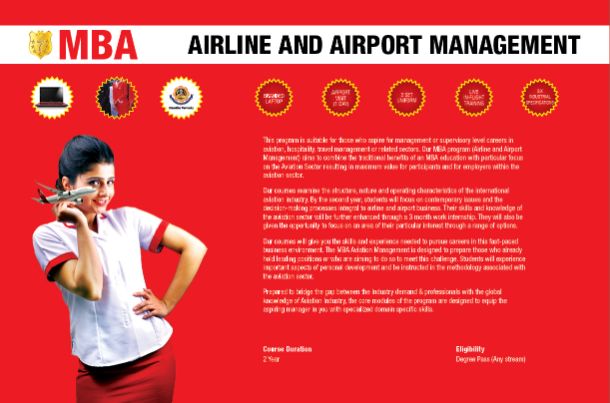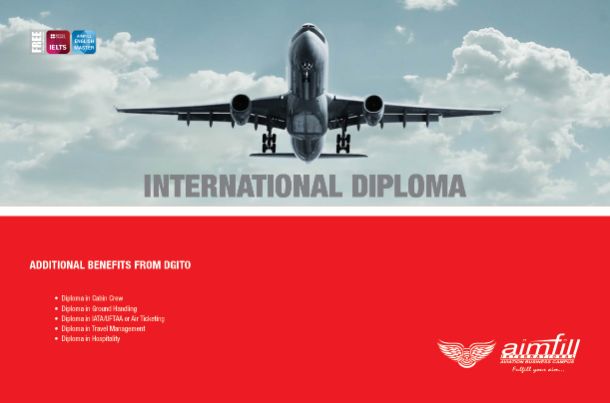

BBA IN AIRLINE AND AIRPORT MANAGEMENT

BBA IN AVIATION
STUDENTS PLACEMENT
STUDENT PLACED IN ONE WEEK OF INITIAL TRAINING

AIMFILL INTERNATIONAL
aviation management
From flight dispatch and ground operations to flight planning and Cabin Crew and more, aviation management programs at Aimfill International, lead to a wide assortment of positions with airlines, airports, private companies, and government agencies
Award Winning Aimfill placements and academic team with huge experience in aviation and grooming sector, made a remarkable history inspiring & placing one million+ Students Wold wide in last 15 years, the team have achieved the immense record of 3480 Placement in just 365 days.


BBA AIRLINE AND AIRPORT MANAGEMENT (INTERNATIONAL) & 14 + Luxurious courses are here for you in Airline Cabin Crew, Flight Dispatcher and Aviation
When it comes to 12th standard passed students, BBA has surprisingly emerged as one of the favorite course among them! BBA aviation is designed for students who want to pursue a career in aviation. Bachelor in Business Administration in Aviation is a business management course which will help the student to work in aviation industry. Aviation provides connection with all the countries of the world and helps in tourism. It is one of the most important services. This industry works with other players in the industry and not alone. When students join for this course they get an idea on the working of airline management, economic issues, operations, planning and support tools in decision making. It is a three year course which provides the students with a lot of scope.

BBA in Airline and Aviation Management manage human resources as well as finance matters, safety measures etc at an Airport.
The course deals with pricing , costs, ways of supplying airline markets and networks, planning of the fleet , design of route network and a lot more. An Airport requires large number of staff to work smoothly and properly. Also, factors like safety and security, technical factors, finances etc also have to be taken care of. To handle all these tasks, trained people are required to manage human resources as well as finance matters, safety measures etc at an Airport. This is when Airport Management professionals come handy! The BBA in Airport Management program has been designed to train students manage staff, deal with technical sections like Air Traffic and Control, maintenance staff, cargo department and coordinate them all, manage finances etc.
BBA Aviation: Key Highlights
Full-Form: Bachelor of Business Administration in Aviation
Duration: 3 years.
Eligibility: Higher secondary degree from a recognized board with 50% Admission Process: Merit-Based/Entrance-Based
BBA Aviation Subjects: Managing information system, airline marketing management, Cargo Introductory course, airline & airport management, air cargo security awareness, etc
BBA Aviation Fees: INR 70,000 to INR 4,00,000 BBA Aviation Salary: INR 4 - 8 LPA
BBA Aviation Jobs: Credit control manager, airport manager, program manager, assistant airport manager, airport operations manager, etc.
Top Recruiting Companies: Air India, India Jet Airways, Alliance Air, Air Costa, Air Heritage, Air Deccan, Air India Charters Ltd, SpiceJet, IndiGo, etc
SUBJECTS & SYLLABUS
BBM/BBA - Aviation Management 2010-11 & onwards- CPOP Page 1 of 39 BHARATHIAR UNIVERSITY
Students will be given 10 Days during the close of the Fifth Semester to do the project and submit the project report based on the subjects taught during the semester. In the case of final semester, 20 Days will be given to do the project which will cover all the subjects taught in the entire programme and the student shall submit the report on the last day. The evaluation of project work will be done by a board consisting of HOD, concerned Faculty &Nominated External Examinations by the University.
MANAGEMENT PROCESS
Goal: To enable the students to learn principles, concepts and functions of management. Objective: On successful completion of this course, the students should have understood. The nature and types of business organizations Principles & functions of Management Process of decision making Modern trends in management process. UNIT -I Business - meaning -business and profession, requirements of a successful business-Organisation - meaning - importance of business organisation. Forms of business Organisation-Sole traders, partnership, Joint Hindu family firm - Joint Stock Companies - Cooperative Organisations - Public Utilities and Public Enterprises. UNIT –II Nature and Scope of Management process – Definitions of Management – Management: a science or an art? - Scientific Management - Managerial functions and roles – The evolution of Management Theory. UNIT –III Planning: meaning and purpose of planning - steps in planning - types of planning. Objectives and Policies - Decision making: Process of Decision making - types of Decisions. UNIT -IV Organising: Types of organisation - Organisationalstructure - span of control - use of staff units and committees. Delegation: Delegation and centralisation - Line and Staff relationship. Staffing: Sources of recruitment - Selection process - training. UNIT - V Directing: Nature and purpose of Directing. Controlling: Need for co-ordination - meaning and importance of controls - control process - Budgetary and non-Budgetary controls - Modern trends in Management Process - case studies. REFERENCE BOOKS
1.Business Organisation - Bhushan Y.K.
2.Principles of Management – L.M. Prasad
3.Business Management – Dinkar Pagare
4. Principles of Business organisation and Management – P.N. REDDY
FINANCIAL ACCOUNTING
Goal: To enable the students to acquire knowledge of Accounting principles and practice Objective: On successful completion of this course, the students should have understood The basic accounting concepts Double entry book keeping system and various books of accounts Preparation of final accounts, etc. UNIT - I Basic Accounting concepts - Kinds of Accounts – Financial Accounting vs. Cost Accounting - Financial Accounting vs. Management Accounting -Double Entry Book Keeping – Rules of Double Entry System – Preparation of Journal and Ledger Accounts- problems - Subsidiary books - cash book – types of cash book -problems - purchase book - sales book - sales return and purchase return books. UNIT - II Trial balance - Errors – types of errors - Rectification of errors – problems - Bank reconciliation statement – problems. UNIT - III Manufacturing - Trading - Profit & Loss Account - Balance sheet. – Problems with simple adjustments. UNIT - IV Accounting for non-trading institutions-Income &Expenditure Account- Receipts and Payment Accounts and Balance sheet - Accounting for depreciation – methods of depreciation – problems (straight line method and written down value method only) UNIT - V Preparation of accounts from incomplete records. (Theory and problems may be in the ratio of 20% and 80%respectively)
REFERENCE BOOKS
1. Grewal, T.S. : Double Entry Book Keeping
2. Jain and Narang : Advanced Accountancy
3. Shukla and Grewal : Advanced Accountancy
4. Gupta and Radhaswamy : Advanced Accountancy
5. Gupta R.L. : Advanced Accountancy B.B.M -Services Management -2010-11 -Colleges
MATHEMATICS FOR MANAGEMENT- I
Goal: To enable the students to acquire knowledge of mathematics & statistics and their use in business decision making. Objective: On successful completion of this course, the students should have understood Set operations, matrix and Mathematics of Finance Statistical tools and their applications UNIT - I Sets and set operation - Venn Diagrams - Elements of Co-ordinate system. Matrices, Fundamental ideas about matrices and their operational rules – Matrix multiplication - Inversion of square matrices of not more than 3rd order- solving system of simultaneous liner equations. UNIT-II Mathematics of Finance and series simple and compound interest - Arithmetic progression - Geometric progression (Simple problems only). UNIT-III Meaning and Definitions of Statistics - Scope and Limitations. Statistical enquiries - Scope of the problem - Methods to be employed types of enquiries - Presentation of data by Diagrammatic and Graphical Method - Formation of Frequency Distribution. UNIT-IV Measures of Central tendency - Arithmetic Mean,Median, Mode, Geometric and Harmonic mean, Measures of variation and standard, mean and quartile deviations - Skew ness and Kurtoses Lorenx curve, Simple Correlation - Scatter diagram - Karl Pearson‘s Co-efficient of correlation – Rank correlation - Regression lines. UNIT-V Analysis of Time Series: Methods of Measuring - Trend and Seasonal variations - Index number - Unweighted indices - Consumers price and cost of living indices. * Questions in theory and problems carry 30% and 70% marks respectively
REFERENCE BOOKS
1. Sundaresan and Jayaseelan - An Introduction to Business Mathematics and Statistical Methods
2. Gupta S.P. - Statistical Methods
3. Navaneethan P. - Business Mathematics
4. Statistics - R.S.N. Pillai, Mrs. Bhagavathi
5. P.R. Vittal - Business Mathematics and Statistics
SEMESTER – II ORGANISATIONAL BEHAVIOR
Goal:
To enable the students to acquire knowledge of organisational behaviour
Objective:
On successful completion of this course, the students should have understood Personality,
Perception, Motivation, Job-satisfaction, morale, Group dynamics, Leadership traits, Counselling
and guidance, etc.
UNIT - I
Importance and scope of organisational psychology – Individual differences - Intelligence tests -
Measurement of intelligence - Personality tests - nature, types and uses.
UNIT - II
Perception - Factors affecting perception - Motivation - theories - financial and non-financial
motivation - techniques of motivation - Transactional Analysis - Brain storming.
UNIT - III
Job satisfaction - meaning - factors – theories - Management of job satisfaction - Morale -
importance - Employee attitude and behaviour and their significance to employee productivity -
job enrichment - job enlargement.
UNIT – IV
Hawthorne Experiment - importance - Group Dynamics - Cohesiveness – Co-operation
competition - conflict - Types of Conflict – Resolution of conflict - Sociometry - Group norms -
Role - Status – supervision style - Training for supervisions.
UNIT - V
Leadership - types - theories – Trait, Managerial Grid, Fiedder‘s contingency - Organisational
culture, Organisational change - organisational effectiveness – organisational development -
counselling and guidance - Importance of counsellor- types of counselling - merits of
counselling.REFERENCE BOOKS
1. Sundaresan and Jayaseelan - An Introduction to Business Mathematics and Statistical Methods
2. Gupta S.P. - Statistical Methods
3. Navaneethan P. - Business Mathematics
4. Statistics - R.S.N. Pillai, Mrs. Bhagavathi
5. P.R. Vittal - Business Mathematics and Statistics
lespanio
beauty and wellness


MODELING, ACTING, TV ANCHORING AND RADIO JOCKEYING AND STILL PHOTOGRAPHY COURSE
AIMFILL INTERNATIONAL
FRONT OFFICE ASSOCIATE

AIMFILL INTERNATIONAL
HOTEL & HOSPITALITY MANAGEMENT

newyork INTERNATIONAL
ca cma MANAGEMENT

Aida & FfTV
costume and fashion













































